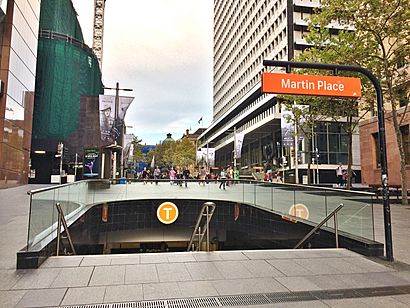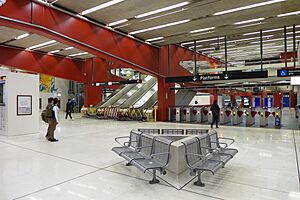Martin Place railway station facts for kids
Quick facts for kids
Martin Place
|
||||||||||||||||||||||||||||||||||||
|---|---|---|---|---|---|---|---|---|---|---|---|---|---|---|---|---|---|---|---|---|---|---|---|---|---|---|---|---|---|---|---|---|---|---|---|---|

Elizabeth Street entrance in April 2017
|
||||||||||||||||||||||||||||||||||||
| Location | Martin Place, Sydney central business district, City of Sydney, New South Wales, Australia | |||||||||||||||||||||||||||||||||||
| Coordinates | 33°52′04″S 151°12′37″E / 33.86785°S 151.21014°E | |||||||||||||||||||||||||||||||||||
| Owned by | Transport Asset Holding Entity | |||||||||||||||||||||||||||||||||||
| Operated by | Sydney Trains | |||||||||||||||||||||||||||||||||||
| Line(s) | Eastern Suburbs | |||||||||||||||||||||||||||||||||||
| Distance | 2.1 kilometres (1.3 mi) from Central | |||||||||||||||||||||||||||||||||||
| Platforms | 2 (1 island) | |||||||||||||||||||||||||||||||||||
| Tracks | 2 | |||||||||||||||||||||||||||||||||||
| Connections | Bus | |||||||||||||||||||||||||||||||||||
| Construction | ||||||||||||||||||||||||||||||||||||
| Structure type | Underground | |||||||||||||||||||||||||||||||||||
| Disabled access | Yes | |||||||||||||||||||||||||||||||||||
| Other information | ||||||||||||||||||||||||||||||||||||
| Status | Staffed | |||||||||||||||||||||||||||||||||||
| Station code | MPC | |||||||||||||||||||||||||||||||||||
| Website | Transport for NSW | |||||||||||||||||||||||||||||||||||
| History | ||||||||||||||||||||||||||||||||||||
| Opened | 23 June 1979 | |||||||||||||||||||||||||||||||||||
| Electrified | Yes | |||||||||||||||||||||||||||||||||||
| Traffic | ||||||||||||||||||||||||||||||||||||
| Passengers (2018) | 50,250 (daily) (Sydney Trains, NSW TrainLink) | |||||||||||||||||||||||||||||||||||
| Rank | 10 | |||||||||||||||||||||||||||||||||||
| Services | ||||||||||||||||||||||||||||||||||||
|
||||||||||||||||||||||||||||||||||||
| Official name | Martin Place Railway Station | |||||||||||||||||||||||||||||||||||
| Type | State heritage (built) | |||||||||||||||||||||||||||||||||||
| Designated | 2 April 1999 | |||||||||||||||||||||||||||||||||||
| Reference no. | 1187 | |||||||||||||||||||||||||||||||||||
| Type | Railway Platform/ Station | |||||||||||||||||||||||||||||||||||
| Category | Transport - Rail | |||||||||||||||||||||||||||||||||||
Martin Place railway station is an important underground train station in Sydney, New South Wales, Australia. It's located right in the heart of the city's main business area, called the Sydney central business district. The station is part of the Eastern Suburbs line.
This station is named after Martin Place, a famous pedestrian area above ground. It serves both Sydney Trains' T4 Eastern Suburbs & Illawarra Line and NSW TrainLink's South Coast Line. The station was designed by Fowell, Mansfield Jarvis and McLurcan and opened in 1979. It's even listed on the New South Wales State Heritage Register because of its special history and design.
Contents
Station History: Building an Underground Link
Martin Place Station first opened its doors on 23 June 1979. It was a big part of the new Eastern Suburbs Railway (ESR) line. The station was built using a method called "open-cut excavation." This means they dug a big trench from the surface, built the station, and then covered it up.
The Eastern Suburbs Railway Project
Plans for a train line to Sydney's eastern suburbs have been around since the late 1800s. Even when the City Circle underground stations were built in the 1920s, engineers made space for this future line. However, construction didn't really start until much later.
A law passed in 1947 allowed for new electric train lines in Sydney. This included lines for the eastern, southern, and south-eastern suburbs. The Eastern Suburbs Railway project faced many challenges. It was built on and off for a long time, starting in the late 1940s and making real progress in the 1970s. Building the line also meant buying and demolishing many buildings, especially in Woolloomooloo, which caused some debate.
Martin Place Station's Role in the City
The area known as Martin Place was developed in stages between 1860 and 1935. It became a pedestrian-only area between 1968 and 1978. The final look of Martin Place was decided after many discussions between the City Council, the government, and private landowners.
By the late 1960s, Martin Place had become a pedestrian plaza up to Pitt Street. A new city plan in 1971 aimed to improve how people moved around the city, especially on foot. This plan included extending Martin Place as a pedestrian plaza all the way to Macquarie Street.
The design of Martin Place Railway Station was very important for this extension. It helped shape the eastern end of the plaza. The train line near Macquarie Street was about 30 metres underground. The main concourse (the large public area) for the station was also below street level. It stretched from under Phillip Street to Macquarie Street.
There were plans for entrances with escalators from both Phillip Street and Macquarie Street down to the concourse. There were also ideas to connect the station concourse to shopping areas under Elizabeth Street. This would create an underground path for people.
The area above ground, between Pitt Street and Castlereagh Street, was also designed. A raised terrace was planned near Pitt Street. At the Castlereagh Street end, a sunken amphitheatre was proposed for public events. From here, a shopping arcade would lead under Castlereagh Street to the railway concourse. This underground connection was a key part of the plan.
The final section of Martin Place, between Phillip and Macquarie Streets, was designed as an important arrival point in the city. A large fountain was planned there, along with outdoor cafes near the railway entrance.
The Eastern Suburbs Railway line officially opened in 1979. The shopping arcade and connection to the railway station were completed a few years later, in 1982. The station's design, by Fowell Mansfield Jarvis & Maclurcan Pty Ltd, won an award in 1979. Each station on the Eastern Suburbs Railway had a different colour to help people identify it. Martin Place used bright red tiles and painted surfaces. This red colour was chosen to represent the banking and finance businesses in the area.
In 2010, the station was upgraded with two lifts and an accessible toilet, making it easier for everyone to use. This upgrade finished in April 2011. Looking to the future, two more platforms are planned to open at Martin Place in 2024 as part of the Sydney Metro City & Southwest project.
Station Layout: How it Works
Martin Place station is completely underground. You can get into the station from Martin Place using stairs. Then, you'll find sets of three escalators that take you down to the concourse level. There are also underground walkways that connect the station to nearby office buildings and shops.
The ceiling of the public concourse is angled, following the shape of the street above. The concrete beams that support the ceiling are painted red, matching the red ceramic tiles on the walls.
The station has one island platform with two sides. Trains arrive and depart from both sides. You reach the platform using two sets of three escalators. The station and platforms are built with strong concrete. They are finished with white panels and bright red glazed ceramic tiles on the walls. East of the station, there's a special track called a "turnback siding" where trains can change direction.
There's also a service tunnel that goes from Martin Place station under Sydney Hospital to The Domain. This tunnel carries air conditioning services from an underground room. This room is located beneath two ventilation towers in The Domain, near Sydney Hospital.
Platforms and Services
| Platform | Line | Stopping pattern | Notes |
| 1 |
4
|
services to Cronulla, Waterfall & Helensburgh | |
|---|---|---|---|
|
NSW TrainLink
|
services to Wollongong, Dapto & Kiama | 3 early morning services commence from here | |
| 2 |
4
|
services to Bondi Junction | |
|
NSW TrainLink
|
services to Bondi Junction | 3 early morning services terminate here | |
| 3 | M2 | services to Chatswood, Epping & Tallawong | Under construction (2024) |
| 4 | M2 | services to Central, Sydenham, Dulwich Hill & Bankstown | Under construction (2024) |
Heritage Importance: Why Martin Place Station is Special
Martin Place underground railway station is very important because it represents the newest major railway construction in New South Wales at the time it was built. Being entirely underground, it shows how train station design developed from the 1930s. It uses the latest technology from that era.
It's the only underground railway station built in the centre of Sydney in the last fifty years. It's a great example of a "Late Twentieth-Century International style" building. Many of its original materials and finishes are still in place. The station's design even won an award from the Royal Australian Institute of Architects in 1979.
Martin Place railway station was added to the New South Wales State Heritage Register on 2 April 1999. This means it's officially recognised as a significant historical place.
Images for kids



